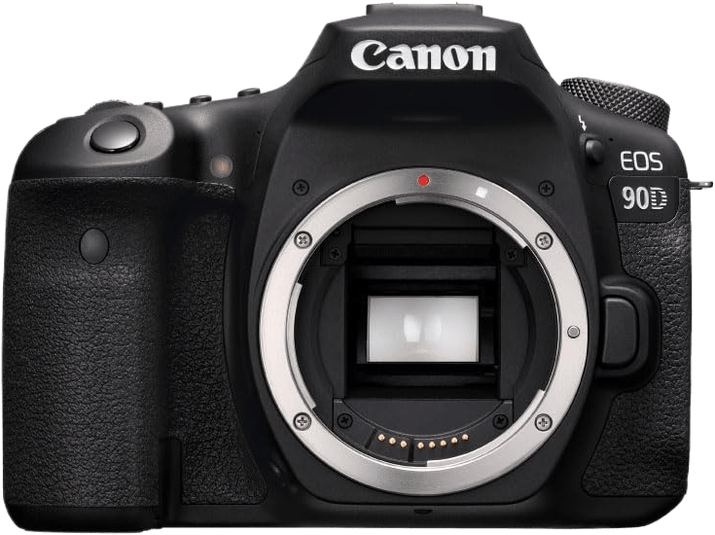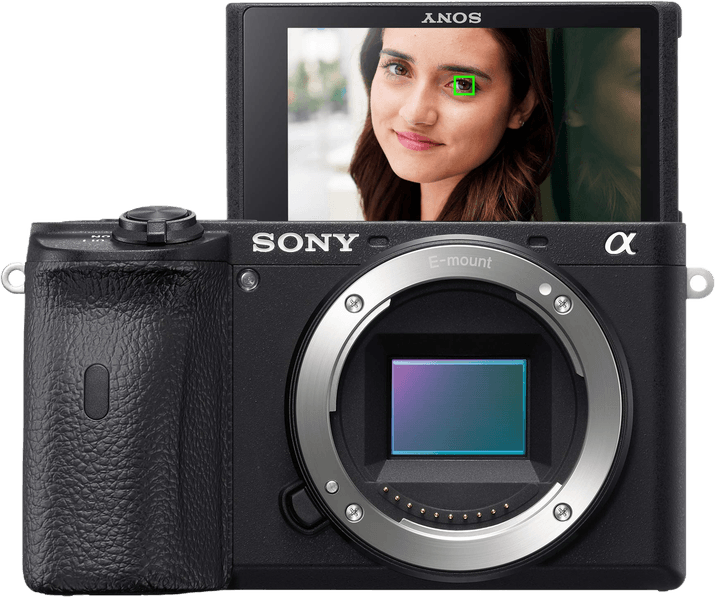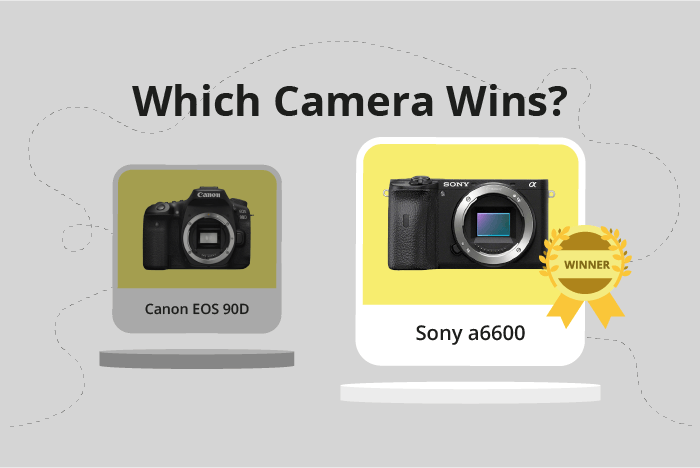Canon EOS 90D vs Sony a6600 Comparison
Canon EOS 90D

Sony a6600

The Sony a6600 outperforms the Canon EOS 90D with a score of 75 to 67. Both cameras were released in 2019 and have a similar launch price of around $1200. They share common specifications such as having an APS-C sensor and being suitable for semi-professional photography.
The Sony a6600, a mirrorless camera, is better in terms of size and weight, being smaller at 120 x 67 x 69mm and lighter at 503g. This makes it more portable and easier to handle. On the other hand, the Canon EOS 90D, a DSLR camera, offers advantages in terms of optical viewfinder and handling, especially for those who prefer a more traditional camera experience.
Taking these factors into account, the Sony a6600 is a better choice for those prioritizing portability and weight, while the Canon EOS 90D may be preferable for photographers who value the advantages of a DSLR.
Canon EOS 90D vs Sony a6600 Overview and Optics
The Sony a6600 outperforms the Canon EOS 90D in terms of optics, scoring 76/100 compared to the Canon’s 62/100. Both cameras share several features, including a CMOS sensor, an APS-C sensor size, and similar shooting speeds (10fps for Canon and 11fps for Sony). However, there are key differences that set these cameras apart in the optics department.
The Sony a6600 boasts a higher DXOMARK sensor score of 82, while the Canon EOS 90D has a lower score of 58. This advantage allows the Sony a6600 to produce better image quality, especially in low light conditions. Additionally, the Sony a6600 features in-body image stabilization, which the Canon EOS 90D lacks. This feature helps reduce camera shake and allows for sharper images in handheld situations.
On the other hand, the Canon EOS 90D offers more megapixels at 33, compared to the Sony a6600’s 24.2 megapixels. This difference allows the Canon to capture more detail in images, potentially making it a better choice for photographers who prioritize high-resolution output.
Despite the higher megapixel count, the Canon EOS 90D falls short in other areas, with a lower overall optics score and the absence of image stabilization. The Sony a6600’s higher DXOMARK sensor score and image stabilization make it the superior choice for those seeking better image quality and performance in various shooting conditions. While the Canon EOS 90D may have its advantages in terms of resolution, the Sony a6600 provides a more well-rounded and versatile optics experience.
Canon EOS 90D vs Sony a6600 Video Performance
The Canon EOS 90D and Sony a6600 share the same video score of 91/100, indicating that both cameras have strong video capabilities. They have several common video specifications, such as maximum video resolution at 4K and maximum video dimensions at 3840 x 2160. Additionally, both cameras have built-in time-lapse functionality.
The Canon EOS 90D has a slight advantage in terms of maximum video frame rate, reaching up to 120fps, while the Sony a6600 offers a maximum of 100fps. This difference allows the EOS 90D to capture smoother slow-motion footage, making it a better choice for videographers who prioritize high frame rates for their projects.
On the other hand, the Sony a6600 does not have any significant advantages over the Canon EOS 90D in terms of video capabilities. Both cameras are evenly matched in most aspects, making the choice between them largely dependent on personal preference and other factors beyond video specifications.
In comparing the video capabilities of the Canon EOS 90D and Sony a6600, both cameras are strong contenders with identical scores and similar specifications. The Canon EOS 90D’s higher frame rate makes it slightly more versatile for slow-motion footage, while the Sony a6600 does not have any notable advantages in this category. Ultimately, the choice between these two cameras will depend on individual needs and preferences, as well as factors beyond video capabilities.
Canon EOS 90D vs Sony a6600 Features and Benefits
The Canon EOS 90D emerges as the winner in the features comparison, scoring 83/100, while the Sony a6600 scores 81/100. Both cameras possess several similar specifications, making them comparable in various aspects.
The Canon EOS 90D and Sony a6600 share common features such as a 3-inch screen size, touchscreen capabilities, flip screens, and the absence of GPS. Additionally, both cameras are equipped with WIFI and Bluetooth connectivity. Despite these similarities, the Canon EOS 90D outperforms the Sony a6600 in certain aspects.
The 90D boasts a higher screen resolution of 1,040,000 dots, compared to the a6600’s 921,600 dots. This difference in screen resolution allows the 90D to provide clearer and sharper image previews, enhancing the user experience.
On the other hand, the Sony a6600 also has its advantages over the Canon EOS 90D. However, these advantages do not contribute to a higher feature score, which is why the a6600 remains at a score of 81/100.
Taking into account the feature scores and specifications, the Canon EOS 90D proves to be the better camera in this comparison, offering a higher screen resolution. While the Sony a6600 remains a strong competitor, its lower feature score and screen resolution place it just behind the 90D. Both cameras have commendable features, but the Canon EOS 90D stands out as the winner in this head-to-head comparison.
Canon EOS 90D vs Sony a6600 Storage and Battery
The Canon EOS 90D and Sony a6600 both have a storage and battery score of 48/100. They share similarities in this aspect, as both cameras have one memory card slot and accept SD/SDHC/SDXC cards. However, the Sony a6600 also accepts Memory Stick Pro Duo cards, providing more storage options.
The Canon EOS 90D excels in battery life, offering 1300 shots per charge with its LP-E6N battery, significantly outlasting the Sony a6600’s 810 shots using the NP-FZ100 battery. The longer battery life makes the EOS 90D more suitable for extended shooting sessions.
On the other hand, the Sony a6600 has the advantage of USB charging, allowing for convenient charging options, especially when traveling or on-the-go. This feature is not present in the Canon EOS 90D.
Despite their identical scores, the Canon EOS 90D offers better battery life, whereas the Sony a6600 provides more storage options and USB charging. Users should consider their individual needs when choosing between these two cameras.
Alternatives to the Canon EOS 90D and Sony a6600
Are you still undecided about which camera is right for you? Have a look at these popular comparisons that feature the Canon EOS 90D or the Sony a6600:

